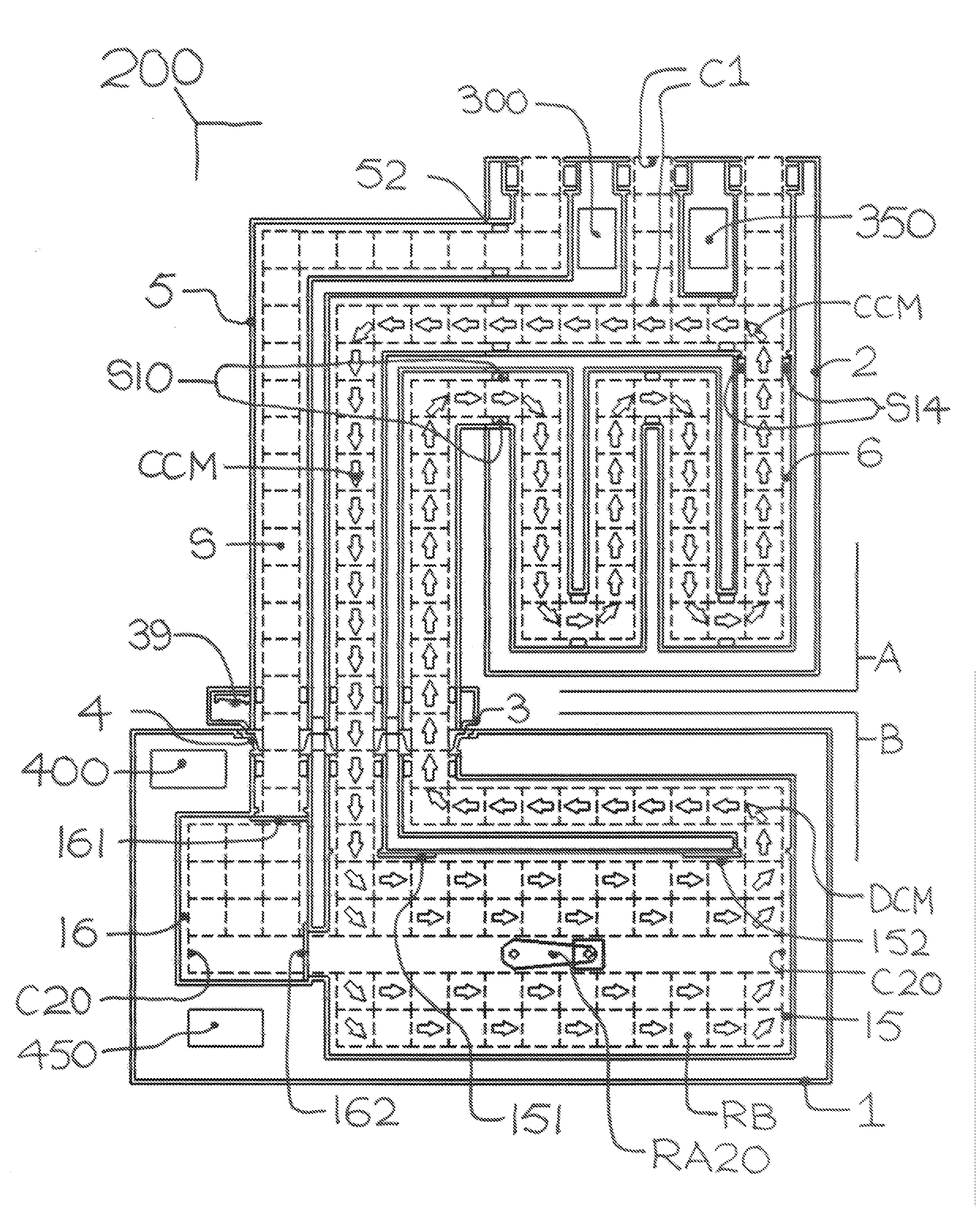Electric Vehicle Refueling System
a technology for electric vehicles and refueling systems, applied in the direction of electric/fluid circuits, metal sawing equipment, climate sustainability, etc., can solve the problems of prohibitive 50% of the purchase price of a new battery powered electric vehicle, the cost of a complete set of rechargeable batteries, etc., and achieves simple structure, high commercial potential, and easy sequential conveying
- Summary
- Abstract
- Description
- Claims
- Application Information
AI Technical Summary
Benefits of technology
Problems solved by technology
Method used
Image
Examples
first embodiments
[0140]FIG. 1 is a general schematic down-view, for defining in introductory terms, the First Embodiments of an Enclosed Computer-Controlled Cyclical Through-Flow Sequential Conveyor System (200), for the sequential computer-controlled conveyance of a very large number of identical individual small-volume rechargeable Cell-Modules (100) through and within an Enclosed System.
[0141]In this drawing, no Cell-Modules (100) are actually shown.
[0142]Instead, the physical extremities of each individual Cell-Module (100), that may be disposed within a System (200), is schematically disclosed by the use of four broken straight lines that together form a bounding Square (S).
[0143]Each Cell-Module's sequentially conveyed position within a simple version of an Enclosed System (200) is thus illustrated by the use of a sequentially positioned Flow-Direction-Arrow within each bounding Square (S).
[0144]An Enclosed System (200) generally comprises a Stationary Part (A) that is shown temporarily but se...
second embodiments
[0403]In the First Embodiment disclosures, means were provided for recharging Depleted Cell-Modules (DCM) within the Casing of a Cell-Module dispensing Bowser (2), prior to conveying them directly from the Bowser, as freshly Charged Cell-Modules (CCM) towards another Vehicle (1), for ‘metered-for-payment’ recycled use therein.
[0404]In a practical application of such a First Embodiment, the Bowser casing would need to be physically enormous, for containing very large numbers of recharging Cell-Modules, especially if the Bowser was being visited by a continuous number of sequential Vehicles, all needing substantial Cell-Module replenishment.
[0405]For the Second Embodiment disclosures, means are specifically not provided for recharging Depleted Cell-Modules (DCM) within the Casing of a Bowser (2).
[0406]Instead, Depleted Cell-Modules that have just been removed from an adjacently parked Vehicle (1) would be conveyed straight through the casing of a Second Embodiment Bowser (2), for then...
third embodiments
[0471]FIG. 22 represents, in its most whittled down visual form, the simplest schematic disclosures for Third Embodiments of an Enclosed Cyclical System (200).
[0472]All the different interacting Conveyors that were previously disclosed for the Stationary part (A), have been reduced to a single semi-circular Conveyor (CB) of endless belt form, that has been installed within the Casing of a simple Cell-Module dispensing Bowser (2).
[0473]Similarly, all the different interacting Conveyors that were previously disclosed for the Movable part (B), have also been reduced to a single semi-circular Conveyor (CV) of endless belt form, that has been installed within the Bodywork of a simple Cell-Module powered electric Vehicle (1).
[0474]The drawing also discloses that when the simple Bowser (2) is temporarily adjoined the simple Vehicle (1), the semi-circular Conveyor (CB) is shown as an arch and the semi-circular Conveyor (CV) is shown as a bowl.
[0475]Eight Cell-Modules (100) are each depicted...
PUM
| Property | Measurement | Unit |
|---|---|---|
| size | aaaaa | aaaaa |
| dead weight | aaaaa | aaaaa |
| dead weight | aaaaa | aaaaa |
Abstract
Description
Claims
Application Information
 Login to View More
Login to View More - R&D
- Intellectual Property
- Life Sciences
- Materials
- Tech Scout
- Unparalleled Data Quality
- Higher Quality Content
- 60% Fewer Hallucinations
Browse by: Latest US Patents, China's latest patents, Technical Efficacy Thesaurus, Application Domain, Technology Topic, Popular Technical Reports.
© 2025 PatSnap. All rights reserved.Legal|Privacy policy|Modern Slavery Act Transparency Statement|Sitemap|About US| Contact US: help@patsnap.com



